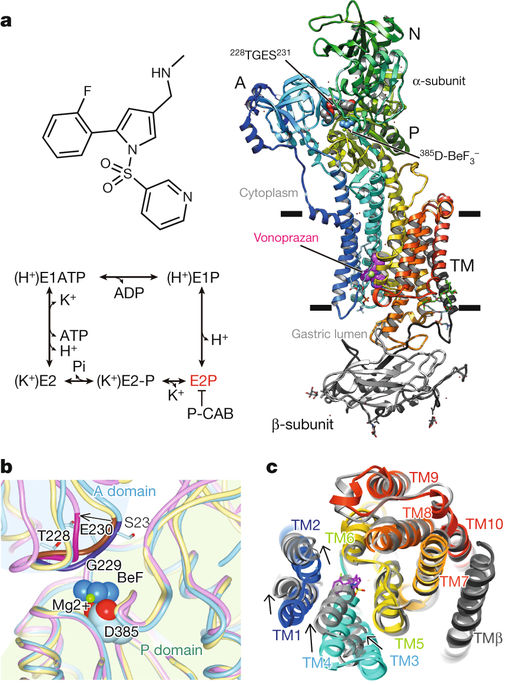Crystal structures of the gastric proton pump
Kazuhiro Abe, Katsumasa Irie, Hanayo Nakanishi, Hiroshi Suzuki, Yoshinori Fujiyoshi
Index: 10.1038/s41586-018-0003-8
Full Text: HTML
Abstract

The gastric proton pump—the H+, K+-ATPase—is a P-type ATPase responsible for acidifying the gastric juice down to pH 1. This corresponds to a million-fold proton gradient across the membrane of the parietal cell, the steepest known cation gradient of any mammalian tissue. The H+, K+-ATPase is an important target for drugs that treat gastric acid-related diseases. Here we present crystal structures of the H+, K+-ATPase in complex with two blockers, vonoprazan and SCH28080, in the luminal-open state, at 2.8 Å resolution. The drugs have partially overlapping but clearly distinct binding modes in the middle of a conduit running from the gastric lumen to the cation-binding site. The crystal structures suggest that the tight configuration at the cation-binding site lowers the pKa value of Glu820 sufficiently to enable the release of a proton even into the pH 1 environment of the stomach.
|
Vms1 and ANKZF1 peptidyl-tRNA hydrolases release nascent cha...
2018-04-09 [10.1038/s41586-018-0022-5] |
|
Fatal swine acute diarrhoea syndrome caused by an HKU2-relat...
2018-04-04 [10.1038/s41586-018-0010-9] |
|
The evolutionary history of vertebrate RNA viruses
2018-04-04 [10.1038/s41586-018-0012-7] |
|
Accelerated increase in plant species richness on mountain s...
2018-04-04 [10.1038/s41586-018-0005-6] |
|
Characterization of the 1S–2S transition in antihydrogen
2018-04-04 [10.1038/s41586-018-0017-2] |